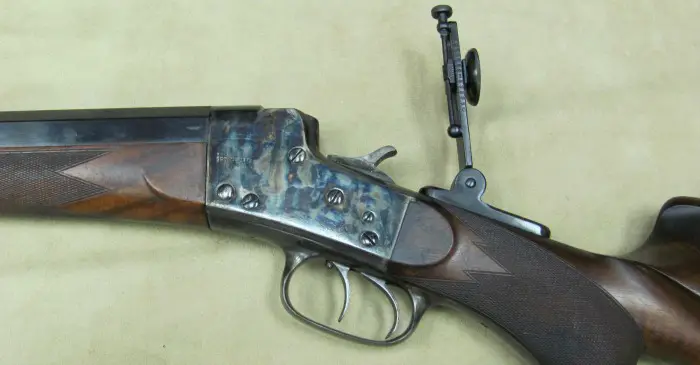|
The Usefulness of Iron Sights By Chuck Hawks  Yesterday, a friend sent me a Sports Afield article by Craig Boddington. Craig Boddington is a very experienced hunter and a fine writer. Like him (I think we are from the same generation) I started "shooting" with the iron sights on a Daisy Red Ryder BB gun. The title of the article in question is "Shootin' Irons." After describing the two basic types of iron sights (open rear sight and aperture/peep rear sight), the author went on to identify three situations in which he generally found iron sights superior to telescopic sights, along with some personal reminiscences about hunts where iron sights were adventagous, or not. Mr. Boddington's three hunting scenarios that favored iron sights were (1) shooting very large animals (elephants) at very short range, (2) shooting treed game (cougars or black bears) at the conclusion of a hunt with hounds and (3) hunting in a blinding rain or snow storm. The first two scenarios typically involve shots measured in feet, not yards, where accurate bullet placement should not be an issue. The inclement weather scenario is more a matter of accidentally being caught afield in a severe storm, than anything else. Obviously, if you cannot see well enough aim properly, don't shoot, regardless of the type of sight on your rifle! Since I will not be elephant hunting at extremely close range, hunting with hounds (I am not a fan of shooting a cornered big game animal out of a tree), or doing anything other than hiking to safety in a severe storm, I will stick to hunting with riflescopes. Not to mention that my eyes have never--even as a child--had the accommodation to allow me to shoot up to my potential with open sights, although I can shoot okay with a peep sight. As Mr. Boddington noted, iron sights are more fragile than most people think. In fact, for my entire adult life iron sights have been more fragile than riflescopes. (By the time I was 18 years old, medium priced riflescopes and mounting systems had been developed to the point where they were extremely rugged.) The idea of "back-up" iron sights in case a scope becomes damaged during a hunt is rather fallacious, as the iron sights are more likely to be damaged (bent or knocked out of alignment) than the riflescope. I probably own more rifles equipped only with iron sights than do most shooters, a total of four, all lever actions. One with factory open sights, two with tang mounted peep sights and one with a receiver mounted aperture sight. I enjoy shooting these rifles at the range or plinking, but I normally do not take them hunting, mostly for safety reasons. Riflescopes are not only more accurate than iron sights, they are proven to be much safer than iron sights in the field, as they give the shooter a clear, magnified look at his target before the trigger is pulled. Since scopes became the dominant form of sight the number of accidental shootings during hunting season has plummeted. Riflescopes have saved many hunters' lives. Scope use also results in far fewer wounded animals that escape to die in agony, a terrific benefit to my way of thinking. Guns and Shooting Online Gunsmithing Editor Rocky Hays just finished restoring a vintage 1883 Remington-Hepburn single shot match rifle (caliber .38-50) for a customer and it wears a tang mounted, target vernier peep sight similar to the one in the photo at the top of this page. Iron sights just don't get better than this! Rocky and I both tried the sight and decided we could shoot this rifle pretty well, if given the chance. (Out to maybe 200 yards, anyway, NOT at 600+ yards, as the match shooters used to do!) Iron sights still have a place on military rifles and on match rifles where the rules prohibit telescopic sights. Beginners learning to shoot should learn how to use iron sights and any well-rounded shooter should know how to use both open and aperture (peep) sights. However, as Craig Boddington noted in his article, their usefulness on contemporary hunting rifles is pretty limited and a riflescope is preferable for the vast majority of hunting situations. |